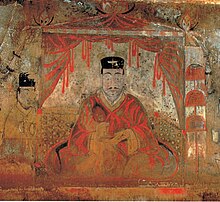
Summary
King Micheon of Goguryeo (died 331, r. 300–331)[1] was the 15th ruler of Goguryeo, the northernmost of the Three Kingdoms of Korea.
| Micheon of Goguryeo | |
 Man from Anak Tomb No.3, presumed to be a depiction of king Micheon in North Korean academia. | |
| Korean name | |
|---|---|
| Hangul | 미천왕 or 호양왕 |
| Hanja | 美川王, 好壤王 |
| Revised Romanization | Micheon-wang or Hoyang-wang |
| McCune–Reischauer | Mich'ŏn-wang |
| Birth name | |
| Hangul | 고을불, 을불리, or 우불 |
| Hanja | 高乙弗, 乙弗利, or 憂弗 |
| Revised Romanization | Go Eul-bul, Eulbulli, or U-bul |
| McCune–Reischauer | Ko Ŭlbul, Ŭlbulli, or Ubul |
Background and rise to the throne edit
He was the grandson of the 13th king Seocheon, and the son of the gochuga Go Dol-go, who was killed by his brother, the 14th king Bongsang.[2]
Korean historical records say that Micheon fled and hid as a servant in a miserable life, doing menial tasks such as throwing stones into a pond throughout the night to keep his master from being awakened. It is said a year later he left that house to become salt peddler but failed to gain huge asset.[3][4] Meanwhile, King Bongsang became increasingly unpopular, and court officials, led by Prime Minister Chang Jo-Ri, carried out a coup that overthrew King Bongsang, and placed King Micheon on the throne.[2]
Reign edit
Micheon continuously developed the Goguryeo army into a very powerful force. During the disintegration of China's Jin Dynasty,[5] he expanded Goguryeo's borders into the Liaodong Peninsula and the other Chinese commanderies.[6] Since the commanderies were nuisances to be eliminated for Goguryeo’s stability, the first military campaign in 302 headed against the Xuantu Commandery,[7] with conquering Daedong River basins of current Pyongyang.[8] Consolidating cut-off between commanderies and Chinese mainland, Goguryeo also annexed the Lelang commandery in 313[1] and Daifang commandery in 314 after attacked Seoanpyeong (西安平; near modern Dandong) in Liaodong.[9] The series of subjugation around northern Korean peninsula and Manchuria held its significance given that 400-year presence of Chinese forces was completely cleared out of Korean peninsula.[6][10]
In his reign, Goguryeo was faced with growing Xianbei influence in the west, particularly the Murong tribe in Liaodong. Micheon allied with other Xianbei Duan and Yuwen tribes against the Murong, but their attack was unsuccessful. In 319, the Goguryeo general Yeo Noja (여노자; 如奴子) was taken captive by the Murong. Throughout this period, Goguryeo and the Murong attacked each other's positions in Liaodong, but neither was able to secure regional hegemony.[5] [6] Since both sides were at stake, Micheon sent an ambassador to the Later Zhao dynasty in 330 with a view to making a diversion against the Murong.[11]
Death and aftermath edit
Micheon died and was buried in 331 at Micheon-won, literally the "garden with beautiful stream".[6] Twelve years later, in the reign of King Gogugwon, his remains were dug up by the Former Yan invaders, and held for ransom.
Family edit
- Father: Prince Dolgo (돌고; 咄固)
- Grandfather: King Seocheon (서천왕; 西川王)
- Grandmother: Queen, of the U clan (왕후 우씨; 王后 于氏)
- Wife: Queen, of the Ju clan (왕후 주씨; 王后 周氏); taken as a hostage alongside the king's corpse in 342 when Mo Yong-hwang (모용황) invaded Goguryeo until able to return in 355.
- Son: Prince Sayu (사유, 斯由; d. 371)
- Son: Prince Mu (무; 武)
See also edit
References edit
- ^ a b Shin, Hyungshik (2006). A brief history of Korea (2 ed.). Seoul: Ewha Womans University Press. p. 25. ISBN 9788973006199. Retrieved 31 January 2016.
- ^ a b "King Bongsang". KBS Radio. Korean Broadcasting System. Retrieved 31 January 2016.
- ^ "King Micheon (1)". KBS Radio. Korean Broadcasting System. Retrieved 31 January 2016.
- ^ Jin, Gwan (2008). 고구려 시대 의 불교 수용사 연구 (in Korean). Seoul: Kyŏngsŏwŏn. p. 164. ISBN 9788992062787. Retrieved 31 January 2016.
- ^ a b Northeast History Foundation (2007). "Journal of Northeast Asian History". Journal of Northeast Asian History. 4 (1–2): 95–96.
- ^ a b c d "King Micheon(2)". KBS Radio. Korean Broadcasting System. Retrieved 31 January 2016.
- ^ 고구려의 정치와 사회. Seoul: Northeast Asia History Foundation. 2007. p. 11. ISBN 9788961870153.
- ^ Yu, Chai-Shin (2012). The new history of Korean civilization. Bloomington, In: IUniverse. p. 26. ISBN 9781462055593. Retrieved 1 February 2016.
- ^ Kim, Bushik. Samguk Sagi(三國史記 卷第十七 髙句麗本紀 第五). Retrieved 1 February 2016. 十二年, 秋八月, 遣将襲取遼東西安平.
- ^ "Three Kingdoms and other States". Korea.net. Retrieved 1 February 2016.
- ^ Kim, Bushik (1145). Samguk Sagi (三國史記 卷第十七 髙句麗本紀 第五). Retrieved 1 February 2016.三十一年, 遣使後趙石勒, 致其楛矢.


